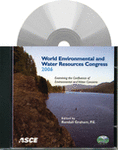The Natural Channel Design Method for River Restoration
Publication: World Environmental and Water Resource Congress 2006: Examining the Confluence of Environmental and Water Concerns
Abstract
Research and restoration implementation of nearly four decades has resulted in the development of the principles and procedural sequences of natural channel design. The procedure includes the implementation of fluvial geomorphology relations to assist in stability assessments, as well as the application of sedimentological, hydraulic and morphological relations. Procedures for natural channel design include analog, empirical, and analytical methods. The proper implementation of this approach requires fundamental training and experience using this Fluvial Geomorphology method. Experience and formal training in geomorphology, hydrology and engineering is required to implement this method. The restoration specialists must also have the ability to integrate principles from multiple disciplines, such as fishery biology and plant science, and most importantly, they must be able to implement the design in the field. Sediment competence and capacity computations are key parts of the assessment and design phases. The methodology is broken into eight major sequential phases (1) Define specific restoration objectives associated with physical, biological and/or chemical process, (2) Develop regional and localized specific information on geomorphologic characterization, hydrology and hydraulics, (3) Conduct a watershed/river assessment to determine river potential, current state and the nature, magnitude, direction, duration and consequences of change. Obtain concurrent biological data (limiting factor analysis) on a parallel track with the physical data, (4) Consider passive restoration recommendations based on land use change, in lieu of mechanical restoration. If passive methods are reasonable to meet objectives, skip to the monitoring phase (8). If passive efforts and/or recovery potential do not meet stated multiple objectives, then proceed with the following phases, (5) Initiate natural channel design with subsequent analytical testing of hydraulic and sediment transport (competence and capacity) relationship, (6) Select and design stabilization/enhancement/vegetative establishment measures and materials to maintain dimension, pattern and profile to meet stated objectives, (7) Implement the proposed design and stabilization measures involving layout, water quality control and construction staging; and (8) Design a plan for effectiveness, validation and implementation monitoring to ensure stated objectives are met, prediction methods are appropriate and the construction is implemented as designed. Finally, design and implement a maintenance plan.
Get full access to this chapter
View all available purchase options and get full access to this chapter.
Information & Authors
Information
Published In
Copyright
© 2006 American Society of Civil Engineers.
History
Published online: Apr 26, 2012
ASCE Technical Topics:
- Biological processes
- Channel stabilization
- Channels (waterway)
- Construction materials
- Data analysis
- Design (by type)
- Ecological restoration
- Ecosystems
- Engineering fundamentals
- Engineering materials (by type)
- Environmental engineering
- Geology
- Geomorphology
- Geotechnical engineering
- Hydraulic design
- Hydraulic engineering
- Hydraulic structures
- Materials engineering
- Methodology (by type)
- Research methods (by type)
- River engineering
- Rivers and streams
- Waste management
- Water and water resources
- Waterways
Authors
Metrics & Citations
Metrics
Citations
Download citation
If you have the appropriate software installed, you can download article citation data to the citation manager of your choice. Simply select your manager software from the list below and click Download.
